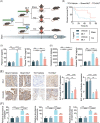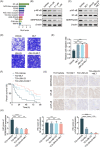Melatonin supplementation protects against traumatic colon injury by regulating SERPINA3N protein expression
- PMID: 38868216
- PMCID: PMC10989984
- DOI: 10.1002/imt2.141
Melatonin supplementation protects against traumatic colon injury by regulating SERPINA3N protein expression
Abstract
Traumatic colon injury (TCI) is a typical injury with high mortality. Prolongation of the intervention time window is a potentially useful approach to improving the outcomes of TCI casualties. This study aimed to identify the pathological mechanisms of TCI and to develop effective strategies to extend the survival time. A semicircular incision was made to prepare a TCI model using C57BL/6 mice. An overview of microbiota dysregulation was achieved by metagenome sequencing. Protein expression reprogramming in the intestinal epithelium was investigated using proteomics profiling. The mice that were subjected to TCI died within a short period of time when not treated. Gut symbiosis showed abrupt turbulence, and specific pathogenic bacteria rapidly proliferated. The protein expression in the intestinal epithelium was also reprogrammed. Among the differentially expressed proteins, SERPINA3N was overexpressed after TCI modeling. Deletion of Serpina3n prolonged the posttraumatic survival time of mice with TCI by improving gut homeostasis in vivo. To promote the translational application of this research, the effects of melatonin (MLT), an oral inhibitor of the SERPINA3N protein, were further investigated. MLT effectively downregulated SERPINA3N expression and mitigated TCI-induced death by suppressing the NF-κB signaling pathway. Our findings prove that preventive administration of MLT serves as an effective regimen to prolong the posttraumatic survival time by restoring gut homeostasis perturbed by TCI. It may become a novel strategy for improving the prognosis of patients suffering from TCI.
Keywords: SERPINA3N; gut homeostasis; melatonin; microbiota dysbiosis; posttraumatic survival time; traumatic colon injury.
© 2023 The Authors. iMeta published by John Wiley & Sons Australia, Ltd on behalf of iMeta Science.
Conflict of interest statement
The authors declare no conflict of interest.
Figures






References
LinkOut - more resources
Full Text Sources
Miscellaneous
